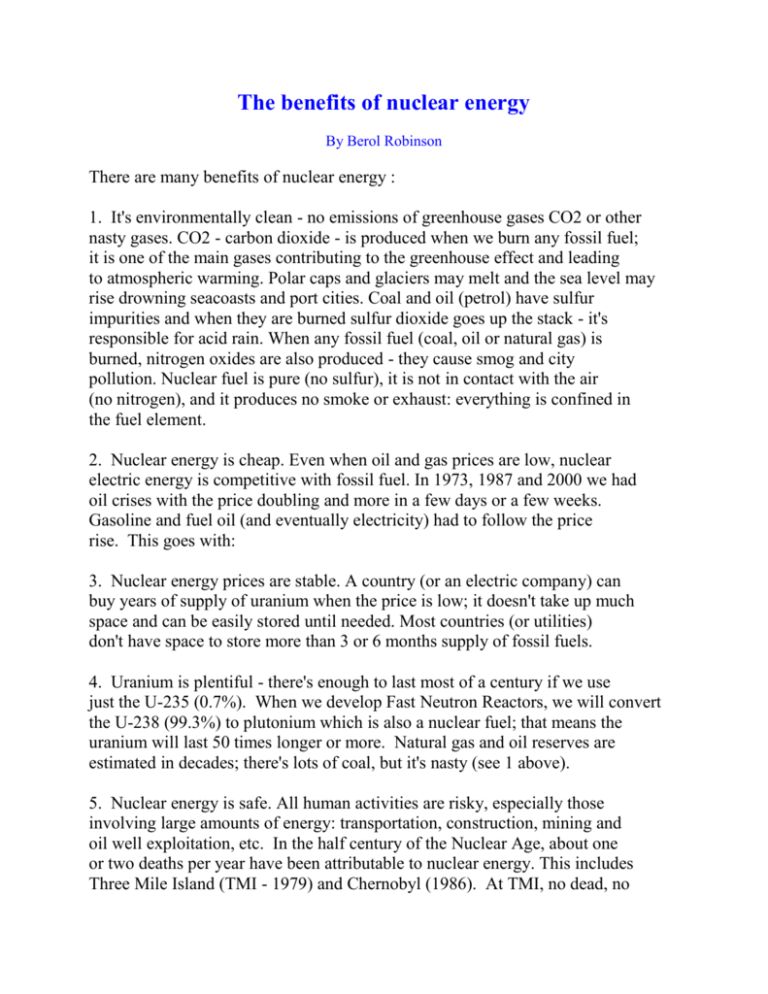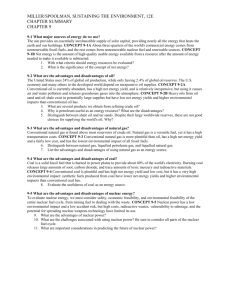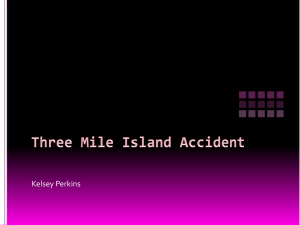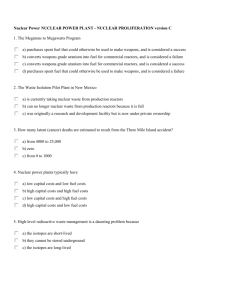The benefits of nuclear energy
advertisement

The benefits of nuclear energy By Berol Robinson There are many benefits of nuclear energy : 1. It's environmentally clean - no emissions of greenhouse gases CO2 or other nasty gases. CO2 - carbon dioxide - is produced when we burn any fossil fuel; it is one of the main gases contributing to the greenhouse effect and leading to atmospheric warming. Polar caps and glaciers may melt and the sea level may rise drowning seacoasts and port cities. Coal and oil (petrol) have sulfur impurities and when they are burned sulfur dioxide goes up the stack - it's responsible for acid rain. When any fossil fuel (coal, oil or natural gas) is burned, nitrogen oxides are also produced - they cause smog and city pollution. Nuclear fuel is pure (no sulfur), it is not in contact with the air (no nitrogen), and it produces no smoke or exhaust: everything is confined in the fuel element. 2. Nuclear energy is cheap. Even when oil and gas prices are low, nuclear electric energy is competitive with fossil fuel. In 1973, 1987 and 2000 we had oil crises with the price doubling and more in a few days or a few weeks. Gasoline and fuel oil (and eventually electricity) had to follow the price rise. This goes with: 3. Nuclear energy prices are stable. A country (or an electric company) can buy years of supply of uranium when the price is low; it doesn't take up much space and can be easily stored until needed. Most countries (or utilities) don't have space to store more than 3 or 6 months supply of fossil fuels. 4. Uranium is plentiful - there's enough to last most of a century if we use just the U-235 (0.7%). When we develop Fast Neutron Reactors, we will convert the U-238 (99.3%) to plutonium which is also a nuclear fuel; that means the uranium will last 50 times longer or more. Natural gas and oil reserves are estimated in decades; there's lots of coal, but it's nasty (see 1 above). 5. Nuclear energy is safe. All human activities are risky, especially those involving large amounts of energy: transportation, construction, mining and oil well exploitation, etc. In the half century of the Nuclear Age, about one or two deaths per year have been attributable to nuclear energy. This includes Three Mile Island (TMI - 1979) and Chernobyl (1986). At TMI, no dead, no injured, no one much irradiated off the site of the power station - probably more people were killed in traffic accidents while trying to flee in mistaken terror (see below). At Chernobyl, about 50 people died as a result of the accident - they were workers in the plant and firefighters; about 1500 people got thyroid cancers from eating food contaminated with radio-iodine, but that disease can usually be treated with success - less than ten have died of it. On the other hand, you often hear about coal mine accidents with tens to hundreds dead in each accident. There was a big one in China this week! You may hear less about oil field accidents - they are less spectacular - not so many dead at any one time, but the numbers add up. 5.1 The next generation of nuclear power stations will be safer and more efficient: they are being developed in California and in South Africa. 5.2 If the same safety requirements were imposed on mining, oil exploitation and the chemical industry, they would be put out of business. 6. Coal, oil and gas are precious feedstock materials for the chemical industry and relatively scarce (see 4 above) - all kinds of plastics start with these inputs, for example. They should not be wasted by burning them for their energy content. 7. Many people are concerned about radioactivity and waste products. 7.1 We live in a constant bath of ionizing radiation from cosmic rays, from radon in the atmosphere, from the radioactive potassium and carbon-14 in our own bodies. This accounts for about 2/3 of the dose you get - you can't escape it. About 1/3 comes from medical treatment - xrays and so forth - your dentist uses xrays to find out about your teeth before he begins drilling. About 1% (one percent!) comes from atmospheric tests of nuclear weapons, fortunately suspended some years ago, but some radioactivity lingers on. Much less than one tenth of one percent is due to nuclear energy generating stations. 7.2 In generating nuclear energy, the waste products (fission products) are completely confined in the cladding of the fuel elements. When they come out of the reactor, they are highly radioactive - "hot", but the radioactivity decays quickly. So they are stored on the site for a year or two until they are "cool" enough to be shipped to a reprocessing plant or to permanent storage. You can't say the same about fossil fuels - their waste products are dumped into the atmosphere - go up the stack - come out of the exhaust pipe. 7.3 The volume of nuclear waste produced in making enough electric energy to run an all-electric household for 30 years would fit in a cigarette package. 7.4 It is believed that tens of thousands of pregnant women had unnecessary abortions after the Chernobyl accident; they were afraid that the foetuses they were carrying would be deformed by the radiation, and their doctors were equally ignorant or unable to convince them that there was little risk. These were truly victims of the accident. 7.5 People are afraid of things that they don't understand, that they can't see; and that includes "ghosties and ghoulies and things that go bump in the night" as well as radioactivity and radiation. This lack of knowledge is fed upon by what I like to call "merchants of fear" - it makes juicy stories and helps sell their newpapers and magazines - never mind that what they tell is not true - so long as the cash keeps rolling in. Learn about it and don't be afraid! Berol Robinson Local correspondent of EFN for North America _______________________________ Visit our website : http://www.ecolo.org and click on "Documents" for more information.











